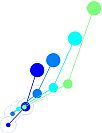The prefrontal cortex (PFC) is critical for flexible decision-making, and dynamical motifs have been identified in PFC population activity that could support certain aspects of this process (e.g., context-dependent line attractors for sensory input integration). PFC is also known to encode a plethora of decision-relevant variables, including task progression, action, and value. It remains an open question whether there are dynamical motifs that track all these variables to inform decisions. Further, it is unclear how outcome feedback alters neural representations of these variables and impacts the evolution of network dynamics. Here we addressed these unknowns by examining population dynamics and single neuron activity in the medial PFC (mPFC) as rats made foraging decisions in an environment where probabilistic rewards were distributed over multiple foraging patches. On each trial, rats chose to stay within their current patch or switch to alternative patches based on their estimates of the relative value between the local and distant locations. We found regular structure in mPFC population activity that resembled a high-dimensional ‘spiral' where trial progression drove rotational dynamics that were displaced by value. Unrewarded trials shifted the system in a direction associated with a patch-switch decision, but when the rat switched to a new patch, the system was reset in the opposite, patch-stay direction even before an outcome was experienced in that patch. This spiral-like motif was expressed across different patches and for different actions, with each spiral located in a different region of the neural state space, preserving information about places and trial types. These features arose from individual neurons selective for path progression, action, and/or patch identity with multiplicative modulation by value. Our results demonstrate that the geometry of prefrontal dynamics and associated single neuron representations are well-suited to track task-relevant variables and support adaptive decisions across a variety of conditions.
- Poster

 PDF version
PDF version

